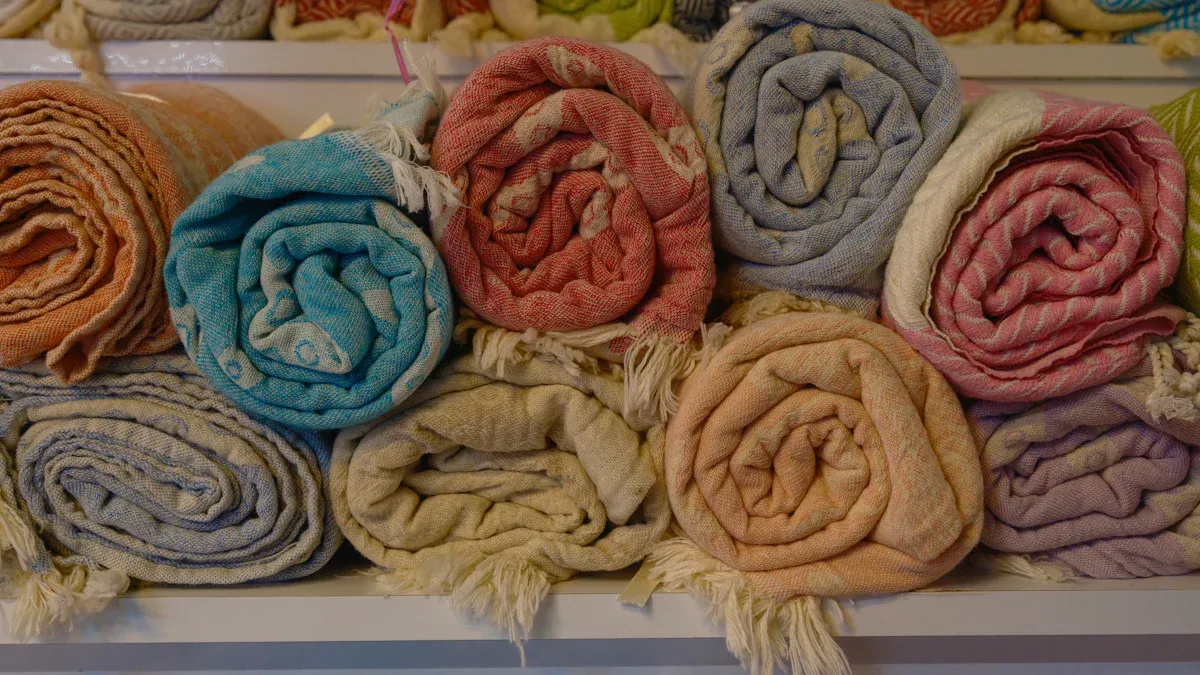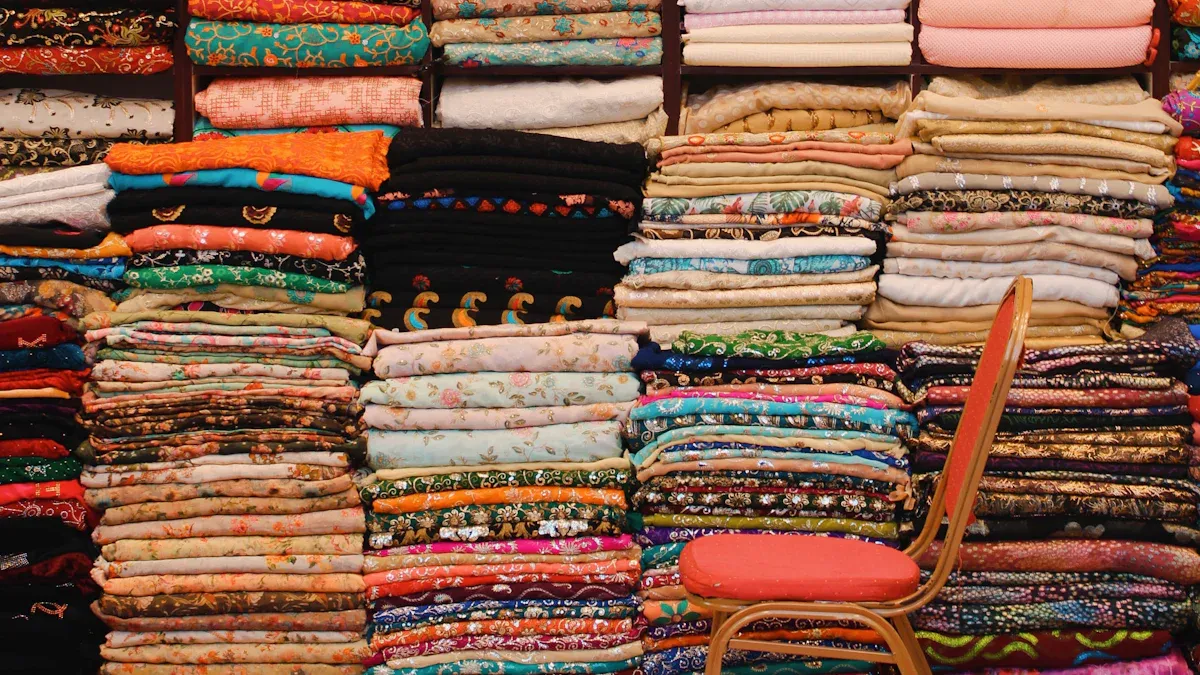
Buying hacci fabric online can feel tricky for beginners. You cannot touch or stretch the hachi before you order. Many beginners struggle to judge the texture and drape of hachi from a screen. This fabric guide helps you learn what to look for when choosing hachi and where to buy it. Trusted sites like Fimka Store and Clos make finding hachi easy. With this guide, you gain the knowledge to pick the right hacci fabric and avoid common mistakes beginners face. Use this fabric guide to shop for hachi with confidence.
Key Takeaways
- Hacci fabric feels soft and stretches easily. It has a loopy texture. People use it to make sweaters, joggers, and pajamas. These clothes feel cozy and nice to wear.
- You can pick brushed hacci if you want it warm and soft. Non-brushed hacci is lighter and looks more classic. Pick the one that fits your project best.
- Look at the fiber blends, weight, and stretch of the fabric. This helps you choose the right hacci for your sewing project. It will fit well and feel comfortable.
- Always ask for a fabric sample before you buy online. Check for certifications like OEKO-TEX or GOTS. These show the fabric is good quality.
- Take care of hacci by washing it in cold water. Let it air dry. This keeps its shape, softness, and stretch. Your hacci will last a long time.
Hacci Fabric Overview: Key Facts and Uses

What Is Hacci Fabric
You may see the word hachi or hacci fabric when shopping for cozy textiles. Hachi is a type of sweater knit that stands out for its loopy, open-knit texture. Textile experts say hachi uses blends like polyester, cotton, wool, or spandex. This blend gives hachi a unique feel and look. Hachi is not the same as cotton ribbed knits or jersey knits. You will notice that hachi feels much softer and more textured than regular knits. Most people use hachi for sweaters and cardigans, but you can find it in many other garments.
Key Features of Hacci Fabric
Hacci fabric has several features that make it special.
- The loopy, open-knit texture lets air flow, so hachi feels breathable and cozy.
- Hachi uses a weft knitting method. This helps the fabric stay smooth and stable.
- The loose-knit structure gives hachi natural stretch. Your garments will fit snugly but still let you move easily.
- Hachi can be brushed or peached. This makes the surface even softer and warmer, almost like fleece.
- Hachi fabric resists wrinkles and keeps its shape after many washes.
- You can find hachi in blends with polyester, viscose, rayon, spandex, or eco-friendly fibers. These blends let you pick the right texture and stretch for your garments.
Tip: Hachi is easy to sew, so beginners often choose it for their first knit projects.
Most Popular and Practical Uses of Hacci Fabric
You can use hachi for many types of garments. The most common uses include sweaters, cardigans, joggers, pajamas, and tops. Hachi works well for both casual and stylish clothing. Many designers pick hachi for its soft feel and cozy look. If you want to make loungewear or winter wear, hachi is a great choice. Hachi’s stretch and breathability also make it perfect for activewear. When you look for ideal projects for hachi fabric, think about any garment that needs to be soft, stretchy, and comfortable.
| Garment Type | Why Use Hachi? |
|---|---|
| Sweaters | Soft, warm, and cozy |
| Cardigans | Breathable, stylish |
| Joggers | Stretchy, comfortable |
| Pajamas | Soft, gentle on skin |
| Tops | Lightweight, drapes well |
Types of Hacci and Variations

Finishing: Brushed Hacci vs. Non-brushed Hacci
When you look for hachi fabric, you will see brushed and non-brushed types. Brushed hachi is made by using metal brushes to lift the fibers. This makes the fabric feel soft and fluffy, almost like fleece. Brushed hachi feels warmer and is gentle on your skin. Non-brushed hachi keeps its usual loopy, open-knit look. Both types do not wrinkle easily and keep their shape after washing. Brushed hachi is good for sweaters, joggers, and warm accessories. Non-brushed hachi is better for projects that need a lighter, classic look. Wash brushed hachi gently to keep it soft. Non-brushed hachi needs the same care but is a little stronger.
Tip: Pick brushed hachi if you want your project to feel soft and cozy. Choose non-brushed hachi for a lighter, more classic feel.
Color Yarn Blends: Single Color Hacci, Two-tone Hacci, Tricolor Hacci
Hachi fabric comes in many color blends. You can get single color hachi for a simple look. Two-tone hachi uses two yarn colors for a soft pattern or heathered style. Tricolor hachi mixes three yarn colors for a bright, bold look. These color choices help you match your project to your style. Two-tone and tricolor hachi make tops and cardigans look more interesting. When you sew with these blends, you get both comfort and style.
Fiber Composition Blends: Poly, Rayon, Spandex Hacci
Hachi fabric uses different fiber blends to change how it feels and works. Common blends are polyester, rayon, and spandex. Polyester and spandex blends make hachi strong and stretchy. This helps your clothes fit well and move with you. Rayon makes hachi soft and smooth. Some hachi fabrics use eco-friendly fibers like bamboo or recycled polyester. Suerte sells hachi knit fabric with many blend choices, like polyester, viscose, rayon, spandex, and green fibers. You can pick the blend that fits your sewing needs, like extra stretch, light weight, or a soft drape.
| Fiber Blend | Performance Benefit |
|---|---|
| Polyester/Spandex | Strong, stretchy, and light |
| Rayon | Soft, smooth, and light |
| Bamboo/Eco-friendly | Good for the planet, airy, and light |
Note: Lightweight hachi with spandex is great for activewear and loungewear. It stretches and goes back to shape, so sewing is easy and fun.
You might see hachi spelled as hacci or hatchi. All these spellings mean the same knit fabric. When you search online, try all three spellings. This helps you find more fabric choices for your projects. Stores and brands use these names in the same way, so searching with just one spelling may give you fewer results.
Selecting and Using Hacci Fabric
How to Choose the Right Hacci Fabric for Your Project
When you start sewing with hachi, you need to think about your project’s needs. Each hachi fabric has its own blend and texture. You should look at the material composition. Polyester gives durability, cotton adds breathability, and spandex makes hachi stretchy. Organic cotton blends work well for gentle, sustainable sewing. Check the width and weight of hachi. Wider fabrics let you cut patterns easily. Lightweight hachi is perfect for delicate garments, while heavier hachi gives structure. Always check the stretch and recovery. Stretchy hachi works best for neckbands, cuffs, and fitted sewing. For loungewear or pajamas, pick hachi with a soft finish. If you sew for kids, choose hachi that feels soft and is hypoallergenic. You can also read customer reviews to see if the hachi meets your needs.
Tip: Always match the texture of hachi to the look you want. Smooth hachi gives a clean style, while textured hachi adds interest.
Match the Weight and Stretch of Hacci Fabric to Your Sewing Project
Matching hachi fabric to garments is important for a good result. Hachi comes in light to medium weights. Lightweight hachi drapes well and feels comfortable. It works for tops and dresses. Medium-weight hachi gives more body and warmth, making it great for sweaters and joggers. The stretch in hachi helps your garments fit well. Stretchy hachi lets you move easily and keeps its shape. If you want a loose, cozy sweater, pick hachi with more drape and stretch. For tighter fits, use hachi with less drape but good stretch. Hachi’s balance of thickness and stretch makes it a favorite for fall and winter sewing. You can use hachi for many types of garments, from activewear to casual tops.
| Hachi Weight | Best Use | Stretch Level |
|---|---|---|
| Lightweight | Tops, dresses | High |
| Medium-weight | Sweaters, joggers | Medium-High |
Care Tips for Maintaining the Quality and Longevity of Hacci Fabric
Proper care keeps your hachi fabric looking new. Wash hachi by hand with lukewarm water and mild detergent. You can also use a washing machine on a delicate cycle with cold water. Avoid scrubbing or twisting hachi, as this can damage the loose-knit weave. Use a mesh laundry bag to protect hachi during washing. Air dry hachi flat on a towel in a shaded area. This helps keep its shape and stretch. If you use a dryer, choose the lowest heat and remove hachi while still damp. Store hachi folded or on padded hangers in a cool, dry place. Keep hachi away from direct sunlight to prevent fading. Handle hachi gently during washing, drying, and storage to keep it stretchy and soft for many sewing projects.
Note: Gentle care helps your hachi fabric last longer and keeps your garments looking their best.
Evaluating Suerte Online Sellers
Suerte Reputation and Customer Reviews
When you shop for hacci fabric online, you want a seller you can trust. Suerte is known for being reliable for many reasons:
- Suerte works hard to make new products and uses eco-friendly ways to make fabric.
- The company follows rules for safe and green fabric, like OEKO-TEX® and GOTS certifications.
- Many people trust Suerte because of good reviews. About 72% of businesses say reviews help them pick a supplier.
- Customers like Suerte’s fair prices, which are great for buying a lot at once.
- People say the fabric is soft, stretchy, and lasts long, even after washing many times.
- Suerte’s support team answers fast and helps with special orders, which buyers like.
- The company’s motto is “customer first, reputation first.” This shows in their growing sales and loyal shoppers.
- Experts say Suerte keeps getting better at quality and service, so people trust them more over time.
If you want more places to buy fabric online, you can check sites like Alibaba or ThomasNet. These sites let you compare sellers by their certifications and reviews. You can also use LinkedIn to read feedback and talk to other buyers.
Understanding Suerte Policies, Return Options, and Customer Support Services
Always check the return and refund rules before you buy fabric online. Suerte makes this simple with clear rules that protect you if the fabric is not what you wanted. The company answers questions fast and gives lots of details about each product. This helps you feel sure about your order. Good customer support means you get help with special orders or any problems. Suerte’s quick and helpful service makes them a top pick for many buyers. Always read the return policy and ask customer service if you have questions. Good rules and fast answers show that a seller cares about your trust and happiness.
Assessing Hacci Fabric Quality
When you shop for hachi online, you want to make sure you get the best quality for your sewing projects. Start by reading the product description carefully. Look for details about fiber content, fabric weight, and stretch. For example, a good hachi might list its material as 75% polyester, 20% rayon, and 5% spandex. You may also see the weight, such as 220 GSM, and the width, like 66 inches. These numbers help you know if the hachi will work for your sewing needs.
Here is a table of key quality indicators you should check before buying hachi:
| Indicator | What to Look For |
|---|---|
| Material Composition | Polyester, rayon, spandex blends |
| Fabric Weight (GSM) | 180-220 GSM for most apparel |
| Width | 60-68 inches is common |
| Stretch | Good recovery, soft feel |
| Certifications | GOTS, OEKO-TEX for safety and sustainability |
| Sample Service | Physical samples available |
| Customer Service | Fast replies, clear return policies |
You should always request a physical sample of hachi if possible. Suerte offers free A4 size samples, so you can touch and test the fabric before you buy a large amount. This helps you check the softness, stretch, and thickness in person. You can even try a small sewing test with the sample to see how it handles.
Certifications matter when you want to trust the hachi you buy. Look for labels like GOTS or OEKO-TEX. These show the hachi meets safety and eco-friendly standards. You can check the certificate number online to make sure it is real.
Follow these steps to check hachi quality before you buy:
- Read the product description for fiber content, weight, and width.
- Request a physical sample to test the hachi for sewing.
- Check for up-to-date certifications and verify them online.
- Ask about return policies and customer support.
By following these tips, you make sure your hachi is perfect for any sewing project, from cozy sweaters to stylish tops.
You now have all the steps for buying hachi fabric online. First, learn about the different hachi types and blends. Use this guide to look at sellers and check the fabric’s quality. Many beginners want to know if hachi shrinks, how to sew it, and how much to buy. Always get a swatch to see the color and feel the texture. This guide helps you avoid mistakes and pick the best hachi for your project. With more practice, buying hachi online will get easier and more fun. You can share your hachi stories or questions in the comments below!
FAQ
How do you know if hacci fabric is good quality?
Check the product description for fiber content, weight, and stretch. Request a sample if possible. Look for certifications like OEKO-TEX® or GOTS. Read customer reviews for real feedback.
Tip: Touching a sample helps you judge softness and stretch best.
Does hacci fabric shrink after washing?
Most hacci fabrics resist shrinking, especially blends with polyester or spandex. Always follow care instructions. Wash in cold water and air dry to keep the fabric’s shape.
Can you sew hacci fabric with a regular sewing machine?
Yes, you can sew hacci fabric with a regular sewing machine. Use a ballpoint needle and a stretch stitch. Test on a scrap first for best results.
- Use a walking foot for smoother sewing.
- Set a lower tension if needed.
What is the minimum order for Suerte’s hacci knit fabric?
Suerte’s minimum order is 300 kilograms per color. You can request a free A4 sample before placing a bulk order.
Note: Samples arrive in 3-5 days, and bulk orders ship in 20-30 days.



